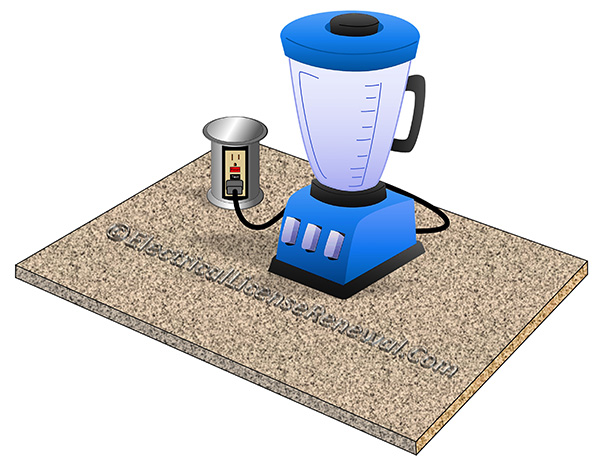406.5(E) Receptacles in Countertops and Similar Work Surfaces.

Code Change Summary: New language was added to expand the rules on receptacles installed in countertops and similar work surfaces.
The 2011 NEC® had rules on receptacles in countertops and work surfaces for dwellings but was silent on similar applications for other than dwellings. In the 2014 NEC®, the rules were expanded to apply to any installation, not just dwellings. As well, the revised language now recognizes that there are receptacle assemblies that have been specifically listed to be installed in face up positions and for countertop installations.
There are several UL Standards that address receptacles and receptacle assemblies for installation in countertops and work surfaces. The 2014 NEC® has requirements for receptacles installed in countertops and similar work surfaces but does not differentiate between the two applications. Receptacle assemblies are subjected to different tests depending on whether a receptacle will be installed in a countertop (such as in a kitchen) or a work surface (such as a conference room table).
Listed directly below are three UL standards that have provisions for testing receptacles and GFCI receptacles installed in a countertop. They address the spillage of up to 32oz (1/2 gallon) of liquid on to the installed receptacle outlet assembly.
- UL 111 Multioutlet Assemblies
- UL 498 the Standard for Safety for Attachment Plugs and Receptacles
- UL 943 the Standard for Safety for Ground-Fault Circuit-Interrupters
Listed below are five UL standards that have provisions for testing receptacles and GFCI receptacles installed in a work surface. They address the spillage of liquid on to receptacle outlets mounted on the desk or table but require spillage of only 8oz (1 cup) of liquid.
- UL 111 Multioutlet Assemblies
- UL 962 Household and Commercial Furnishings
- UL 962A Furniture Power Distribution Units
- UL 1286 Office Furnishings
- UL 1363 Relocatable Power Taps
The work surface liquid spill test was originally developed to address a cup of liquid tipped over. The counter mounted test requirements address the larger quantity of liquid which could be expected for receptacles recessed into countertops located in kitchens or bathrooms.
The differences between the two applications will be made clear in the 2017 NEC®. Since a receptacle assembly that was tested for countertop applications is subjected to a larger amount of spilled liquid, it is also suitable for installation in a work surface, but it doesn’t work the other way around.
A receptacle assembly tested only for a work surface is not permitted to be recessed into a kitchen counter.
Below is a preview of the NEC®. See the actual NEC® text at NFPA.ORG for the complete code section. Once there, click on the “free access” tab and select the applicable year of NFPA 70 (National Electrical code).
2011 Code language:
406.5(E) Receptacles in Countertops and Similar Work Surfaces in Dwelling Units. Receptacles shall not be installed in a face-up position in countertops or similar work surfaces.
2014 Code Language:
406.5(E) Receptacles in Countertops and Similar Work Surfaces. Receptacles, unless listed as receptacle assemblies for countertop applications, shall not be installed in a face-up position in countertops or similar work surfaces. Where receptacle assemblies for countertop applications are required to provide ground-fault circuit-interrupter protection for personnel in accordance with 210.8, such assemblies shall be permitted to be listed as GFCI receptacle assemblies for countertop applications.
Did You Like This? Let Us Know With A Like! Thanks!
406.5(E) Receptacles in Countertops and Similar Work Surfaces.
Below is a Real Question from our Electrical Continuing Education Courses for Electrical License Renewal:Which of the following is true for receptacles installed in countertops and similar work surfaces?
| Please register or sign in for electrical continuing education courses. If you were already signed in, your session probably expired, please sign back in. |